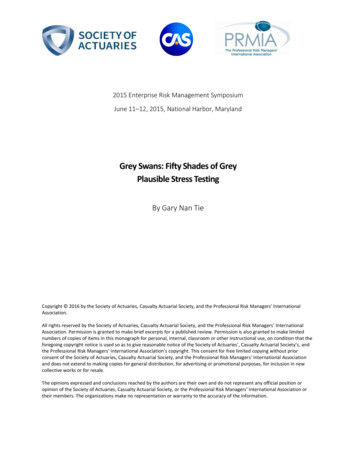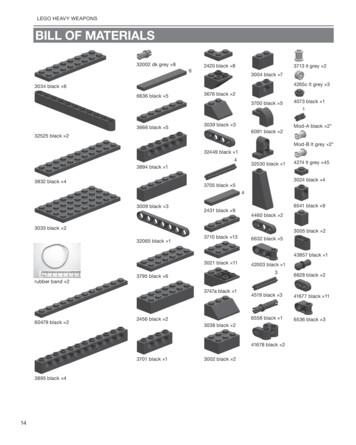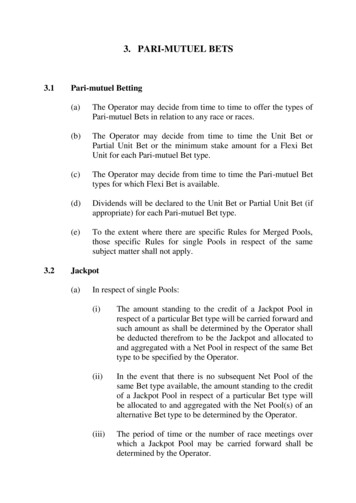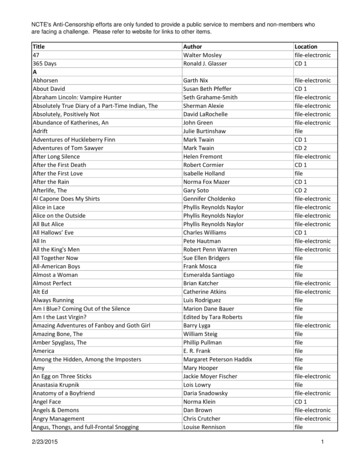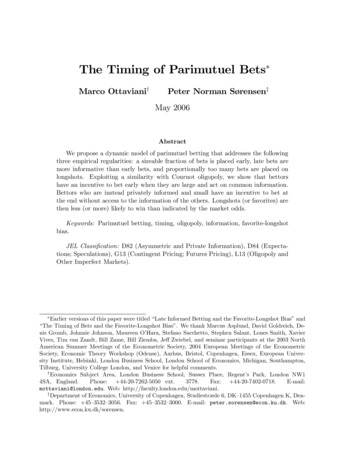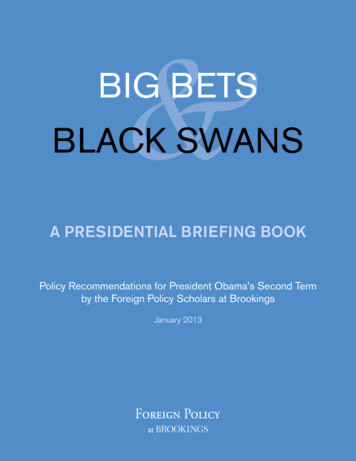
Transcription
&BIG BETSBLACK SWANSA PRESIDENTIAL BRIEFING BOOKPolicy Recommendations for President Obama’s Second Termby the Foreign Policy Scholars at BrookingsJanuary 2013
&BIG BETSBLACK SWANSA PRESIDENTIAL BRIEFING BOOKPolicy Recommendations for President Obama’s Second Termby the Foreign Policy Scholars at BrookingsEdited by Martin Indyk, Tanvi Madan, and Thomas WrightProject Design by Gail ChalefJanuary 2013
I NTRODUCTIONPresident Obama begins his second term at a critical moment in world affairs. Administration officials have already generated internal policy recommendations for dealing with the many challengesthat an unstable world, much of it in turmoil, will present the president in the next four years. In theForeign Policy Program at Brookings, we decided to mirror this process from an outside perspective,taking advantage of the diversity and depth of our scholars’ expertise to generate innovative policyrecommendations for the President.What follows is a series of memos designed to present President Obama with a suggested “to do”list for the major issues of our time. We divided these memos into “Big Bets” and “Black Swans.” TheBig Bets are places where the Foreign Policy scholars believe the President should consider investing his power, time and prestige in major efforts that can have a transformational impact on Americaand the world, as well as on his legacy. The Black Swans are those low probability but high impactevents that can trip the President up and divert him from his higher purposes; events so dramaticallynegative that he will need to take steps in advance to avoid them.The Foreign Policy Program is very grateful to Brookings Trustees David Rubenstein and Ben Jacobs for their generous support of this project. Brookings scholars maintain the highest standardsof quality and independence in their research, analysis and prescriptions. This publication is solely areflection of their individual views.
The Presidential Briefing BookBIG BETSA Plastic Moment by Martin Indyk and Robert Kagan . . . . . . . . . . . . . . . . . . . . . . . . . . . . . . . . . . . . . . . . 1Bringing Beijing Back In by Kenneth Lieberthal . . . . . . . . . . . . . . . . . . . . . . . . . . . . . . . . . . . . . . . . . . . . 5The India Investment by Tanvi Madan . . . . . . . . . . . . . . . . . . . . . . . . . . . . . . . . . . . . . . . . . . . . . . . . . . . . . . 9Turning Tehran by Suzanne Maloney . . . . . . . . . . . . . . . . . . . . . . . . . . . . . . . . . . . . . . . . . . . . . . . . . . . . . . . 14The Road Beyond Damascus by Michael Doran and Salman Shaikh . . . . . . . . . . . . . . . . . . . . . . 19Opening to Havana by Ted Piccone . . . . . . . . . . . . . . . . . . . . . . . . . . . . . . . . . . . . . . . . . . . . . . . . . . . . . . 24Energy and Climate: From Black to Gold to Greenby Charles Ebinger and Kevin Massy . . . . . . . . . . . . . . . . . . . . . . . . . . . . . . . . . . . . . . . . . . . . . . . . . . . . . . . . . .28Free Trade Game Changer by Mireya Solis and Justin Vaisse . . . . . . . . . . . . . . . . . . . . . . . . . . . . . 33Calming the Eastern Seas by Richard Bush, Bruce Jones and Jonathan Pollack . . . . . . . . . . . . 37New Rules of War by Peter W. Singer and Thomas Wright . . . . . . . . . . . . . . . . . . . . . . . . . . . . . . . . . . 41Right-Sizing Defense Cuts by Michael O’Hanlon . . . . . . . . . . . . . . . . . . . . . . . . . . . . . . . . . . . . . . . . . 45Another New START by Steven Pifer . . . . . . . . . . . . . . . . . . . . . . . . . . . . . . . . . . . . . . . . . . . . . . . . . . . . . 50Re-Betting on Turkey by Kemal Kirisci . . . . . . . . . . . . . . . . . . . . . . . . . . . . . . . . . . . . . . . . . . . . . . . . . . . . 56BLACK SWANSChina in Revolution and War by Cheng Li . . . . . . . . . . . . . . . . . . . . . . . . . . . . . . . . . . . . . . . . . . . . . . . 59Eurozoned Out by Justin Vaisse and Thomas Wright . . . . . . . . . . . . . . . . . . . . . . . . . . . . . . . . . . . . . . . . 63Confrontation over Korea by Jonathan Pollack . . . . . . . . . . . . . . . . . . . . . . . . . . . . . . . . . . . . . . . . . . . 67Chaos in Kabul by Vanda Felbab-Brown . . . . . . . . . . . . . . . . . . . . . . . . . . . . . . . . . . . . . . . . . . . . . . . . . . . 71Revolution in Riyadh by Bruce Riedel . . . . . . . . . . . . . . . . . . . . . . . . . . . . . . . . . . . . . . . . . . . . . . . . . . . . . 76Camp David Collapse by Shadi Hamid and Tamara Wittes . . . . . . . . . . . . . . . . . . . . . . . . . . . . . . . . . 80Ramallah Unravels by Khaled Elgindy . . . . . . . . . . . . . . . . . . . . . . . . . . . . . . . . . . . . . . . . . . . . . . . . . . . . . 85The Big Thaw by Elizabeth Ferris . . . . . . . . . . . . . . . . . . . . . . . . . . . . . . . . . . . . . . . . . . . . . . . . . . . . . . . . . . 90THE AUTHORS . . . . . . . . . . . . . . . . . . . . . . . . . . . . . . . . . . . . . . . . . . . . . . . . . . . . . . . . . . . . . . . . . . . . . . . . . . . . . . . . . 95
A PLASTIC MOMENT
MEMORANDUMTo:President ObamaFrom:Martin Indyk and Robert KaganDATE:January 17, 2013BIG BET: A Plastic Moment to Mold a Liberal Global OrderAs you enter your second term, the state of the world is remarkablyunsettled. The leading powers are beset with economic crises or are invarious states of political transition or gridlock. The Middle East is in astate of political upheaval. Tensions are rising in East Asia. The world’sinstitutions, whether the United Nations, the G-20, or the European Union,are weakened and dysfunctional, and seem to be pulling apart in the absenceof concerted leadership. The liberal world order established after theSecond World War — characterized by a free, open international economy, thespread of liberal democracy, and the deepening of liberal, peaceful normsof international behavior — is fraying at the edges.It is a time of uncertainty and instability for the world, and for theUnited States; but it is also a moment of opportunity. Almost a centuryago, when the United States entered the First World War, the philosopherJohn Dewey observed that the world was at a “plastic juncture.” He and manyother progressives believed that the unsettled world of their day offeredthe United States and the other democratic powers a chance to remold theinternational system into something better. Americans walked away from thatchallenge and would embrace it only after a second catastrophic breakdownof world order. Today, we are at another “plastic juncture.” Will Americaturn inward and away from an increasingly messy world? Or will we launcha new effort to strengthen and extend, both geographically and temporally,the liberal world order from which Americans and so many others around theworld have benefited?The answer depends very much on how you choose to make use of your nextfour years in office. Unfortunately, there is not a lot to show for yourfirst four years. In many respects, this is understandable. The economiccrisis that you inherited made steady concentration on foreign policy morechallenging. The two wars you inherited in the Greater Middle East hadbeen bungled by your predecessor and cost the United States dearly, bothmaterially and in terms of reputation. You began to restore that reputationthrough your own global appeal and the efforts of your Secretary of State.B ig B ets and B lack S wans – A Pre s i d e n t i a l B ri e fi n g B o o k1
You have done especially well in raising America’s profile and deepening ourengagement in East Asia. However, so far it is hard to list many durableaccomplishments. Most of the major challenges are much as you found themwhen you took office, or worse: from the stalled Middle East peace processand turmoil in the Arab world to Iran’s continuing march toward a nuclearweapons capability to China’s increasing assertiveness in East Asia. Yourunderstandable preoccupation with reelection has left much of the worldwondering: Where is the United States?For all the talk of American decline from certain quarters, the UnitedStates is actually well-positioned for a new era of global leadership. Ifyou can strike the difficult but necessary compromise with Congress thatbegins to address America’s fiscal crisis, the United States could wellemerge as among the world’s most successful and dynamic economies. Americaenjoys unique advantages in the international economic system: a naturalgas revolution that promises soon to make it a net-exporter of energy, asuperior university education system and an open and innovative economythat continues to attract the world’s best and most creative young minds.On the international stage, the United States remains the only world powerwith global reach, uniquely capable of organizing concerted internationalaction and serving as a source of security and stability to nations andpeoples facing threatening neighbors.Recommendations:How then to take advantage of this plastic moment to mold the changingglobal order to best serve the United States and humankind? We believethat in the next four years you will have a unique opportunity to shape amultilateral global order that will continue to reflect American liberalvalues and progressive ideals. This will require your sustained attention,personal engagement, and direction of the national security agencies of theU.S. government. The reward could be a transformational and lasting impacton the international system, which will redound to the benefit of futuregenerations.In the security realm, your primary “big bet” must be to prevent Iran fromobtaining a nuclear weapons capability. It is hard to imagine a biggerblow to the international security order than the collapse of the nonproliferation regime that would follow Iran’s successful acquisition ofnuclear weapons. Conversely, if you can succeed in achieving meaningfulcurbs on Iran’s nuclear weapons aspirations and reinforce this bynegotiating another nuclear arms reduction agreement with Moscow, youB ig B ets and B lack S wans – A Pre s i d e n t i a l B ri e fi n g B o o k2
will do much to strengthen non-proliferation and nuclear disarmament as afundamental pillar of the new liberal global order.In East Asia, your primary big bet should be on promoting a regional orderthat encourages China to develop in a peaceful and productive direction.You have already formulated a credible strategy; now you will need toencourage China’s new leadership away from greater reliance on militarypower in favor of continued economic and political development at homeand increasing economic and political integration abroad. This will meancontinuing to deepen America’s Asian alliances, especially with the newleaderships in Tokyo and Seoul; building new partnerships with the nationsof the region; and playing a major role in supporting regional cooperation.You should ensure that the rebalancing effort in East Asia goes beyond themilitary to include all aspects of American power. With India, the world’slargest democracy and the other major rising power in Asia, you have laida strong foundation but the next four years will be critical in buildinga partnership that can serve as another pillar of the emerging liberalgeopolitical order.Strengthening the liberal economic order needs to be a higher priorityin your second term. Concluding free trade agreements with the AsiaPacific region and Europe would boost U.S. exports and global economicrecovery while promoting a broader consensus on the necessary standardsto promote free trade and investment in the global economy. Building theinfrastructure and putting in place the policies necessary to exportAmerican natural gas to key allies and partners, especially in Europe andAsia, will help reduce their dependence on Russia and Iran. LeveragingAmerica’s hydrocarbon bonanza to encourage more effective efforts to counterclimate change can help promote a greener global order.Strengthening the liberal political order will require increased efforts toenlist the support of emerging democracies. Nations like Brazil, Indonesia,Mexico, South Africa and Turkey have become increasingly influentialeconomically. But they are struggling to find their identity as democraticpowers on the international stage and, in some cases, are punching belowtheir weight. Some are drifting toward a worldview that actually underminesthe liberal nature of the global order. At the same time, powerfulautocracies like Russia have staked out positions at the United Nations andelsewhere that are antithetical to liberal values — on the issue of Syria,for instance. These autocratic powers need to understand that if theycontinue their obstructionism, the democratic international community willincreasingly move on without them and they will be isolated.B ig B ets and B lack S wans – A Pre s i d e n t i a l B ri e fi n g B o o k3
In your first term, you were reluctant to make democracy a centerpieceof your foreign policy. However, with revolutions in the Arab world andpolitical changes in Burma that you have supported, it is time to place theUnited States once again at the vanguard of the global democracy movement.This is not only because democracy is consonant with American values. Inthe Middle East, in Russia and parts of Eastern Europe, just as in Burmaand the rest of Asia, the United States has strategic, political andeconomic interests in the spread of stable, liberal democracies. Althoughdemocracies can be fractious, and in times of transition unstable, in theend they are more reliable supporters of the liberal world order whichAmericans seek. The United States needs to do more in support of thedifficult struggle for democracy in the Arab world too, including holdingthe Egyptian Muslim Brotherhood government to democratic standards, andmore actively leading the effort to shape a positive democratic outcome inSyria and preventing it from descending into chaos or becoming a haven forjihadists and Iranian proxies. America’s relationship with Russia needsto be shaped by strategic arms agreements as well as by respect for thedesires and aspirations of the Russian people. You should work to steerRussia in a positive direction, strengthening where you can those forces inRussian society that favor economic and political modernization.Finally, the United States needs a global strategy. It cannot focus on onecritical region to the detriment of others. While you were absolutely rightto increase American attention to the vital region of the Asia-Pacific, theUnited States cannot and should not reduce its involvement in the MiddleEast or in Europe. Since the end of the Second World War, the United Stateshas played the key security role in all three regions at once; there isno safe alternative to that. This is particularly true in the MiddleEast, where many nations look to the United States for both protectionand assistance. But even Europe deserves continued American attention andinvolvement. Everything the United States wants to accomplish in the worldcan be better accomplished with the help and cooperation of its Europeanallies.Conclusion:At the end of World War II, the United States led the way in shaping aninternational political, economic, and security order which, for all itsflaws, served the American people, and much of the world, remarkably well.Much is changing in today’s world, but the basic requirements of Americanforeign policy have not. Your great challenge is to seize this plasticmoment and apply your leadership to the preservation and extension of theliberal global order for future generations.B ig B ets and B lack S wans – A Pre s i d e n t i a l B ri e fi n g B o o k4
BRINGING BEIJING BACK IN
MEMORANDUMTo:President ObamaFrom:Kenneth LieberthalDATE:January 17, 2013BIG BET: Bringing Beijing Back InYour rebalancing strategy toward Asia has produced desirable results,including convincing China that the United States is serious, capableand determined to be a leader in the region for the long term. But thisstrategy is also generating dynamics that increasingly threaten toundermine its primary goals. It is therefore time to rebalance judiciouslythe rebalancing strategy, and China’s leadership change provides you withan opportunity to do so.Your objective should remain an Asia that, five-to-10 years from now, willcontribute substantially to global and U.S. economic growth and willmitigate security dilemmas that drain American treasure and reduce theregion’s economic dynamism.Unfortunately, at this point your current strategy is in danger of actuallyenhancing rather than reducing bad security outcomes. Most notably,territorial disputes have become sharper, and Beijing is largely operatingunder the false assumption that the flare-up of these disputes reflects anunderlying U.S. strategy to encourage Japan, Vietnam, and the Philippinesto push the envelope in the hope that Chinese responses will lead thosecountries — and ASEAN — to become more united and dependent on the UnitedStates.Welcome mats for our increased security engagement are now being laid outaround the region. This is satisfying in the short term but carries longerterm risks. U.S. friends and allies are encouraging the United States toenhance its security commitments, but they are also tying their economicfutures to China’s growth. The United States is thus in danger of havingAsia become an ever greater profit center for China (via economic andtrade ties) and a major cost center for the United States (via securitycommitments), especially if the Trans-Pacific Partnership (TPP) does notdevelop as hoped.B ig B ets and B lack S wans – A Pre s i d e n t i a l B ri e fi n g B o o k5
Recommendation:To shift this trajectory, you should take the initiative this spring tosolidify and strengthen the core bilateral relationship with China whilecontinuing to provide reassurances to allies and partners of U.S. stayingpower in the region. Nobody in Asia wants to have to take sides between theUnited States and China, and none any longer fear a G-2. All seek “wisemanagement” of U.S.-China relations. An initiative that improves U.S.-Chinarelations and contributes to regional stability can, therefore, potentiallyenhance U.S. position throughout Asia.Background:China’s leadership change presents an opportunity. Xi Jinping fearsserious challenges to the Chinese system if he cannot improve relationswith a population that has become increasingly vocal, critical andnationalistic. Xi knows he must significantly alter a development model thatis exacerbating social and political tensions, even as the rate of growthslows.Early indications are that Xi is more open and politically agile than wasHu Jintao, but his specific priorities and capacity to effect change arenot yet known. He may take a strong stance on regional issues to signalChina’s determination or he may welcome a chance to tamp down internationaltensions to focus more on domestic transformation. You should give him aclear option to pursue the latter approach.Specifically, you should offer Xi a game-changing opportunity to put U.S.China relations on a more predictable long-term footing that protectscritical Chinese equities but also requires that China engage morepositively on key bilateral, regional and global issues. Any U.S. policythat moves the needle on China’s behavior will be welcome throughout Asia.Beijing is bureaucratically incapable of taking the initiative to suggestthe ideas recommended below. Xi will want the United States to put cards onthe table to which he can then respond — and then the real negotiation willbegin. That lets you shape the opening agenda.The strategy is to offer Xi full good-faith efforts to deal with keyirritants, provided China works with your administration on the areas ofmajor U.S. concern indicated below. You can do important things to changeBeijing’s calculus of American intentions while also advancing specific U.S.interests.B ig B ets and B lack S wans – A Pre s i d e n t i a l B ri e fi n g B o o k6
I recommend that you engage with Xi Jinping early on in order to establisha strong personal relationship with him. Use this to propose working outa four-year framework for U.S.-China relations that establishes a solidfoundation of trust for the next one-to-two decades and provides substanceto China’s mantra of “a new type of major power relationship.” Suggest thatat least four times per year you and he hold half-day summits – not onehour bilaterals — on the margins of multilateral events. Substantively, youmight raise the following for consideration: The current Strategic & Economic Dialog (S&ED) is structurallyvery awkward for China and has never produced a sustained dialogueacross the economic and foreign policy spheres. Propose that it berepackaged into a political and military (pol/mil) dialogue thatis sustained (rather than a brief annual meeting) and a separateeconomic dialogue that closely parallels the Strategic EconomicDialogue that former Treasury Secretary Paulson led. For the pol/mil dialogue, suggest an enhanced Strategic SecurityDialogue (SSD) that convenes four day-long meetings a year, with eachside establishing a working group for ongoing liaison. The StrategicSecurity Dialogue, which met briefly twice under the S&ED, is the onlyformal U.S.-China dialogue that brings together military and foreignpolicy leaders in the same room. At least two of the enhanced SSDmeetings should exclusively address overall U.S. and Chinese securitypostures in Asia a decade hence – basic thinking, pertinent doctrine,core concerns/interests, and areas where mutual restraint may benefitboth sides. The United States has never held such discussions withChina, and they may be critical for building strategic trust.U.S.-China military-to-military (mil-mil) relations lag far behind thoseof their civilian counterparts. Suggest several initiatives to relievesome of the strain in that sphere. The PLA sees restrictions on invitingthem to military exercises as indicative of hostile U.S. expectationsof the relationship. You can indicate the possibility you will use yourwaiver authority to permit PLA participation in various future U.S.organized military exercises (Defense Secretary Panetta has already donethis for RIMPAC 2014). You might also offer serious discussions on militarycooperation to assure better the ongoing flow of reasonably-priced oil fromthe Persian Gulf.Relatedly, maritime territorial disputes are feeding China’s wariness aboutU.S. strategy in the region. You can offer to clarify authoritatively ourprinciples to reduce Chinese suspicions. Such clarification would make clearthat: The United States will take no position on sovereignty in territorialB ig B ets and B lack S wans – A Pre s i d e n t i a l B ri e fi n g B o o k7
disputes to which it is not a party; the United States supports an ASEANcollective negotiation with China on a Code of Conduct in order to reducethe potential for territorial disputes to escalate, but does not seekChinese negotiation with all of ASEAN on resolving territorial disputes;and the United States will adhere to its core principles of peacefulmanagement of disputes, freedom of navigation (including in ExclusiveEconomic Zones), and normal commercial access for American and other firmsto maritime resources.You can suggest various initiatives to enhance economic cooperation.These might include, for example, intensifying negotiations for a U.S.China Bilateral Investment Treaty; inviting China to engage on theTPP when Beijing feels it is able to do so; completing the years-longtechnology export policy review, which can help U.S. business while alsoremoving serious irritants in U.S.-China economic relations; directingthe Department of Commerce and the U.S. Trade Representative to establisha consultative arm to help Chinese firms understand the pertinent U.S.investment laws and regulations; and indicating U.S. interest in workingwith China at the Clean Energy Ministerial to develop cooperative ways formajor emitters to improve their capacity to deal with climate change.The above highlights the scope and some of the content of what you mightindicate to Xi that you are prepared to move forward on as a package, if Xiwill put together a comparable level of efforts on the following issues: Mitigation of tensions over maritime territorial disputesMore extensive U.S.-China mil-mil engagement and discussion of longterm strategic postures in AsiaNorth Korea’s nuclear and missile programsOpening additional areas of the Chinese economy (especially in theservice sector) to American investmentStrengthening enforcement of intellectual property protections andengaging on cyber-security threatsJoint initiatives on climate changeConclusion:Xi may be unable or unwilling to respond significantly to your offer. Buttaking this wide-ranging initiative early on costs little or nothing, sinceyou would be seeking to begin a reciprocal negotiation, not to commit theUnited States to unilateral actions. The payoff is potentially very large inreshaping Chinese and American behavior in ways that will make our overallrebalancing strategy a long-term region-wide success.B ig B ets and B lack S wans – A Pre s i d e n t i a l B ri e fi n g B o o k8
THE INDIA INVESTMENT
MEMORANDUMTo:President ObamaFrom:Tanvi MadanDATE:January 17, 2013BIG BET: The India InvestmentYour administration has made the correct judgment that the rise of Indiaand its increasing role and influence in the international system benefitU.S. interests. This assessment has been articulated repeatedly and enjoysbipartisan support. While Indian policymakers have not been as vocal,their actions have indicated that they too recognize the importance ofthe bilateral relationship. U.S. relations with India are broader anddeeper today than they have ever been. The danger to the relationship isthat it will suffer from inattention – on the Indian side, because of thelack of bureaucratic and political capacity, and policymakers’ domesticpreoccupations; on the U.S. side, because of the lack of a crisis ora single high-profile initiative focusing bureaucratic and politicalattention, and other more-pressing domestic and international concerns.Furthermore, the return on the U.S. investment in India will likely onlymanifest itself in a major way in the medium to long term. That, combinedwith political and economic circumstances in India, might lead to “Indiafatigue” in the United States.Recommendation:You have already made a bet on India. In your second term, as you try toshape the emerging global order in a liberal direction, India’s role willbecome ever more important because of its size, geostrategic location,economic potential and democratic institutions. Accordingly, you need toensure that your administration stays invested in that bet and perhaps evenups the ante. In many instances, it is India that needs to put more chipson the table. However, there are steps that the United States can take tohelp increase the momentum, as well as shape the context in which Indiandecisions are made. These include working with Indian counterparts toimplement existing agreements, conclude current negotiations, and explorenew areas of collaboration, in particular in the energy and educationsectors. Your administration should also signal sustained commitment tothe relationship through continued consultations, high-level visits andtimely personnel appointments. Active efforts are also needed to encourageB ig B ets and B lack S wans – A Pre s i d e n t i a l B ri e fi n g B o o k9
movement on the Indian side, increase public outreach and facilitate theconsolidation and creation of constituencies for the relationship beyondgovernment.Background:The relationship with India has been one of the little-heralded foreignpolicy successes of your first term. The momentum, however, will not sustainitself. Along with the danger of drift, there is likelihood that bilateraldifferences rather than achievements will take center stage. Past irritantsare likely to re-emerge. Your administration and the Indian governmentsuccessfully navigated the tricky Iran sanctions-Indian oil imports issuelast year. However, if the situation with Iran worsens and conflict breaksout, Delhi and Washington might find themselves on opposite sides. TheU.S. relationship with Pakistan, in the context of the withdrawal fromAfghanistan, might create another area of potential difference. The UnitedStates has recently encouraged Indian involvement in Afghanistan and aU.S.-India-Afghanistan trilateral is in place. There are already concernsin India, however, that the U.S. desire to assuage Pakistan to facilitatethe Afghanistan withdrawal might lead to a reversal of that position. Thereare also concerns that the United States will be less likely to pressurePakistan on counter-terrorism issues related to India. Any renewed drivefor the Comprehensive Test Ban Treaty (CTBT) might spark bilateral strainas well. U.S.-India relations have changed since the debate over the CTBTin the 1990s. But the CTBT issue could once again lead to contentionbetween the two countries, which will not be restricted to the privatesphere. Finally, as you carefully calibrate the relationship with the newleadership in Beijing, dormant Indian concerns about a G-2 or Sino-U.S.condominium will also likely arise again.Avoiding drift and the dominance of differences will necessitate gettingmore deliverables from the numerous U.S.-Indian official dialogues. Thismeans implementing agreements that have already been reached. In somecases, the major obstacles to implementation lie on the Indian side — thecivil nuclear agreement is one such example — but there are others wherethe United States needs to act, including in the defense and technologyareas. The expeditious completion of negotiations on other agreementswould also help, including those related to bilateral investment, as wellas
Concluding free trade agreements with the Asia- Pacific region and Europe would boost U.S. exports and global economic recovery while promoting a broader consensus on the necessary standards
